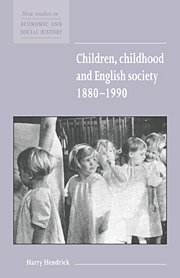Book contents
- Frontmatter
- Contents
- Acknowledgements
- 1 Introduction
- 2 New ideas of childhood: the 1880s to the 1920s
- 3 Parent–child relationships
- 4 Children and social policies
- 5 Children, schooling and the classroom
- 6 Children's leisure
- 7 Conclusion: disappearing childhood and children's rights
- Bibliography
- Index
- Titles available in the New Studies in Economic and Social History series
- Titles available in the Studies in Economic and Social History series
- Economic History Society
3 - Parent–child relationships
Published online by Cambridge University Press: 05 June 2012
- Frontmatter
- Contents
- Acknowledgements
- 1 Introduction
- 2 New ideas of childhood: the 1880s to the 1920s
- 3 Parent–child relationships
- 4 Children and social policies
- 5 Children, schooling and the classroom
- 6 Children's leisure
- 7 Conclusion: disappearing childhood and children's rights
- Bibliography
- Index
- Titles available in the New Studies in Economic and Social History series
- Titles available in the Studies in Economic and Social History series
- Economic History Society
Summary
Since the 1960s family history has become one of the most popular, productive and controversial areas in the development of social history. The debates and schools of thought were superbly summarized by Michael Anderson in an earlier survey in this series [50]. Unfortunately, his period extended only to 1914, which would seem to confirm that there is a paucity of studies covering the interwar and post-Second World War decades.
Anderson focused on three approaches: demography, sentiments and the household economy. Of these, the second is most relevant to this book since it specifically considers parenthood and childhood. Anderson claimed that the principal authors of this school were basically concerned with the emergence of ‘modern’ social relationships, a kind of present-minded history. Rather than examining change or stability in family structures, they were looking for changes in ‘meanings’; in other words, they saw the family not as a reality but as an idea [50: 39].
We are not interested in the broader picture here, but Anderson does raise several points which are directly relevant to twentiethcentury issues. First, in looking for trends in family relationships, we have to remember that ‘in any group of the population more than one set of attitudes may be current at the same period’, and that as attitudes do not change immediately, the ‘old’ and the ‘new’ may well exist together for a long time.
- Type
- Chapter
- Information
- Children, Childhood and English Society, 1880–1990 , pp. 16 - 35Publisher: Cambridge University PressPrint publication year: 1997

